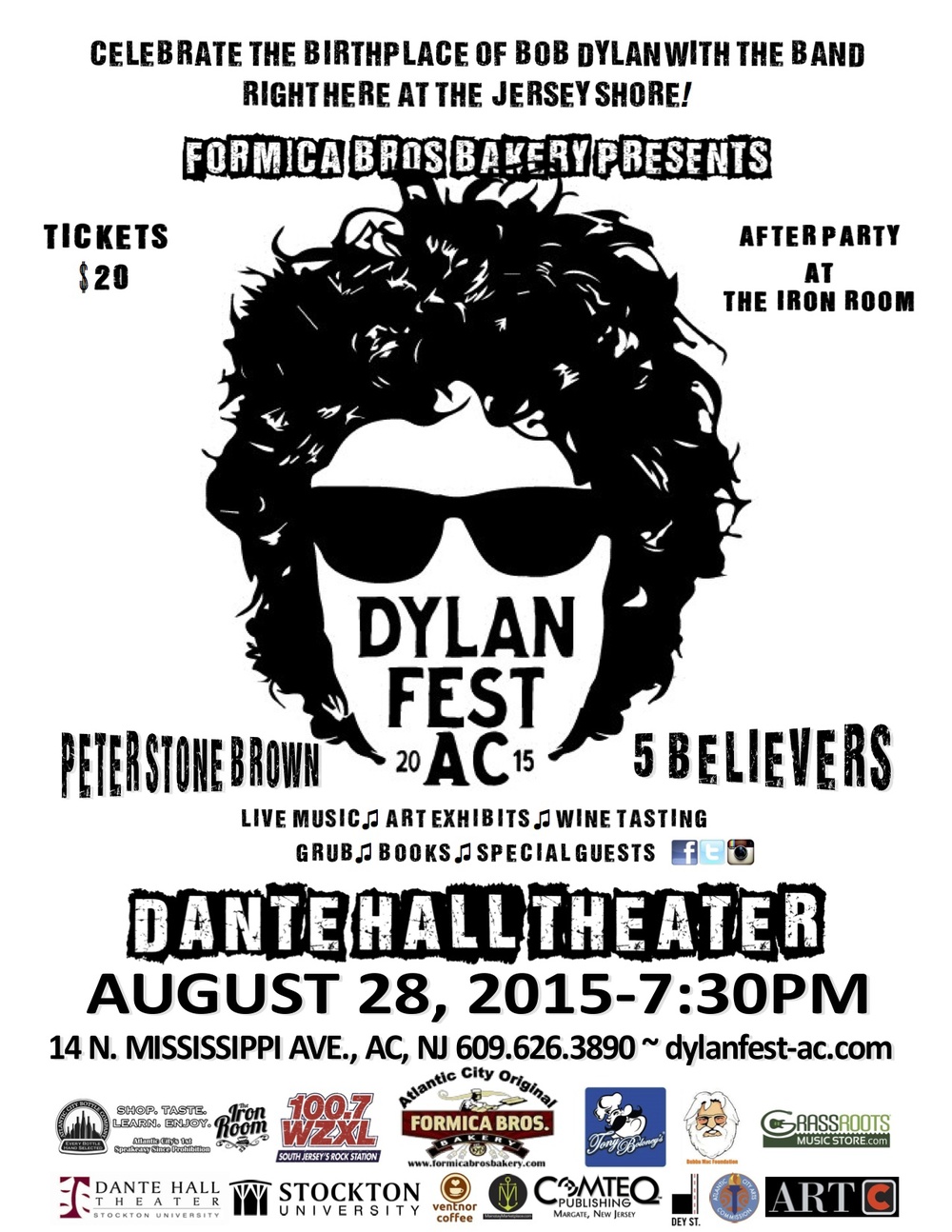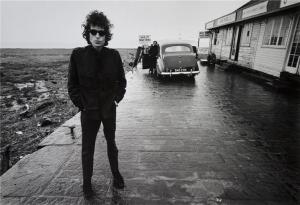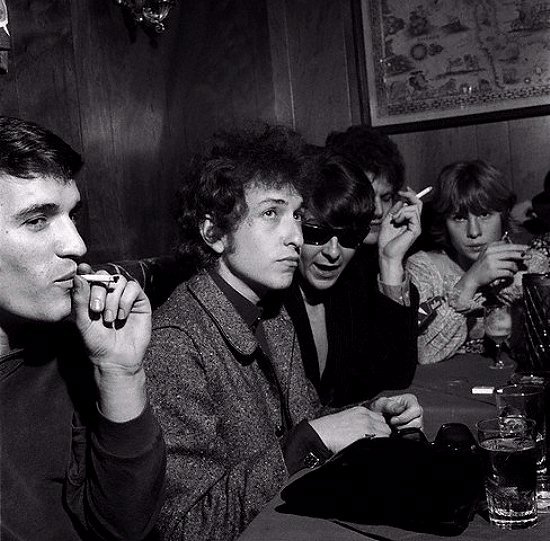The Most Decisive Moment in Rock History - 50 Years Down the Crossroads
If ever there was a moment in time when music was at a crossroads, it was 28 August 1965, 50 years ago, when Bob Dylan “went electric,” what Time Magazine called “the most decisive moment in rock history,” and things still haven’t been the same.
If ever there was a moment in time when music was at a crossroads, it was 28 August 1965, 50 years ago, when Bob Dylan “went electric,” what Time Magazine called “the most decisive moment in rock history,” and things still haven’t been the same.
The myths and legends that have been spun around Dylan
meeting Levon and the Hawks, the whole electric thing, the Basement Tapes,
Woodstock, the Band, the Last Waltz and the trials and tribulations are now all
part of our cultural history.
Sometimes the myths are written in stone, even though
they only contain some semblance of the truth, such as the historical marker in
Toronto, Canada that marks the location of where Friar’s Tavern once stood, and
officially propagates the fact that this was the spot where on Thursday,
September 16, 1965, Bob Dylan met and first played with Levon and the Hawks,
who would become The Band.
Jana Shea, at Newsworks, writes: “It was 50 years ago
(yes, ‘your road is rapidly agin’….’) that Dylan, who had rose to fame as a
folk music singer-songwriter, plugged in and released ‘Bringing It All Back
Home.” After playing the 1965 Newport Folk Festival with (gasp! Boo!) an electrified
sound, he went in search of a back-up band for his next tour. Legend has it
that Dylan discovered the group that would become The Band…in Somers Point
during one of their regular summer gigs at Tony Marts nightclub. Whether the
connection occurred at the Jersey Shore (as festival organizers boast) or
earlier at Friar’s Tavern in Toronto, Canada (per nearly everyone else), the
result was Bob Dylan and The Band hit the road together and forever changed
rock music.”
Toronto reporter and historian John Goddard makes the
case for Dylan meeting the Hawks in Toronto, where they were from and did play
often, and maybe did practice with Dylan in September 1965 before embarking on
their “world tour,” but despite the historical marker and protests from Goddard
and Shea, Dylan did not meet the Hawks for the first time in Toronto on September
16, 1965.
How can that be true if two of the Hawks – drummer Levon
Helm and guitarist Robbie Robertson performed with Dylan at Forest Hills, New
York on August 28, 1965, as they most certainly did in the concert that is pointed
to as “the most decisive moment in rock history.”
Then one of Dylan’s numerous biographers, poo poos the
idea that Dylan called Levon and the Hawks at Tony Marts in Somers Point, NJ
and asked them to join him without having seen or played with them before,
which is exactly what Levon Helm told me and recounts in his autobiography “This
Wheels On Fire.”
Who are we to believe – an unauthorized biographer
writing without the cooperation of those who he is writing about? Or Levon
Helm, one of the principle characters in the story?
And it is a certified fact that Levon and the Hawks were
playing on a nightly basis from late June until mid-August 1965 as the house
band at Tony Marts in Somers Point and were booked and contracted to play three
sets a night until Labor Day, but were let out of their contract in order to play with Dylan at Forest Hills.




The myths that have grown up around
Dylan and the Hawks are legendary, but the real truth is a matter of public
record – and part of the story that I try to recount in the serialized blog The
Summer of ’65 Revisited [that is being posted at http://summerof1965.blogspot.com], which
details the Hawks at the Point and the most accurate account of how Dylan came
to meet them.
After writing and recording “Like a
Rolling Stone,” Dylan wanted a rock band to play with and his manager Albert
Grossman’s Secretary Mary Martin, from Toronto, recommended the Hawks, as did
John Hammond, Jr., who had previously met the Hawks on the road and in Toronto.
Grossman tracked down the Hawks at Tony Marts through their Canadian booking
agent Colonel Harold Kutlets, and Dylan called them there and talked on the
phone with Levon Helm, who didn’t know who Dylan was. Then Levon, Robertson and
maybe Garth Hudson drove to New York City and met Dylan for the first time at
Grossman’s office.
After playing Tony Marts for the last time, Levon Helm and Robbie Robertson played with Dylan at the famous concert at Forest Hills, NY, and then the rest of the Hawks backed Dylan on his tour that included Austin, Texas and the UK.
Read Reviews of the Forest Hills Show:
Peter S. Brown - http://blog.peterstonebrown.com/bob-dylan-at-forest-hills-40-years-later/
Robert Shelton - New York Times - https://www.nytimes.com/books/97/05/04/reviews/dylan-unruly.html
Al Kooper - http://www.villagevoice.com/music/50-years-after-dylan-played-forest-hills-al-kooper-recalls-1965s-electric-summer-7544760
After playing Tony Marts for the last time, Levon Helm and Robbie Robertson played with Dylan at the famous concert at Forest Hills, NY, and then the rest of the Hawks backed Dylan on his tour that included Austin, Texas and the UK.
Read Reviews of the Forest Hills Show:
Peter S. Brown - http://blog.peterstonebrown.com/bob-dylan-at-forest-hills-40-years-later/
Robert Shelton - New York Times - https://www.nytimes.com/books/97/05/04/reviews/dylan-unruly.html
Al Kooper - http://www.villagevoice.com/music/50-years-after-dylan-played-forest-hills-al-kooper-recalls-1965s-electric-summer-7544760
My continuing serial blog “The Summer of 1965 Revisited” [ http://summerof1965.blogspot.com ] also recalls
the conversion of Conway Twitty, who also played Tony Marts that summer, and
successfully converted from a rock and roll star to country music, another
pertinent change in direction that altered the history of music in America.
Conway Twitty’s official web site
biography says: “After eight years of playing sock hops and dance clubs, Twitty
heard the ticking of an internal clock that seemed to guide all the major
decisions in his life. One night on a stage in Summer's Point, New Jersey,
Twitty looked out at a room full of people he didn't know. With a wife and
three kids at home, he realized his days of providing background music for
sweaty teens were over. Twitty put down his guitar, walked off the stage and
embarked on one of the greatest country careers in history. Signed by legendary
producer Owen Bradley to MCA/Decca in 1965, Twitty released several singles
before 1968's "Next In Line" became his first country No. 1. And thus
began a run unmatched in music history. Twitty reeled off 50 consecutive No. 1
hits.”
Most myths and legends are passed on
by vocal tradition and you can tell that this version of Conway Twitty’s career
that talks about “Summer’s Point,” spells Somers Point the way someone who
hears it, and probably heard it from the horse’s mouth – Conway Twitty himself.
As for how Bob Dylan met the Hawks, some of the participants are still alive - Dylan, John Hammond, Jr., Robbie Robertson and Garth Hudson are all alive and Mary Martin should be, so maybe someone should ask them how it all went down.
In the meantime, to commemorate the union of Dylan and the Hawks - Jeff Schwachter and friends are putting on a Dylan Fest show this Friday, August 28 (7:30pm) at the Dante Theater - 14 N. Mississippi Avenue, in Atlantic City, the marvelous music hall now owned by Stockton University, presenting a concert of the songs that Dylan and the Hawks performed at that time as well as some of the songs that made Tony Marts nightclub one of the most famous clubs on the East Coast.
Dante Theater Dylan Fest:
http://intraweb.stockton.edu/eyos/page.cfm?siteID=256&pageID=1
As for how Bob Dylan met the Hawks, some of the participants are still alive - Dylan, John Hammond, Jr., Robbie Robertson and Garth Hudson are all alive and Mary Martin should be, so maybe someone should ask them how it all went down.
In the meantime, to commemorate the union of Dylan and the Hawks - Jeff Schwachter and friends are putting on a Dylan Fest show this Friday, August 28 (7:30pm) at the Dante Theater - 14 N. Mississippi Avenue, in Atlantic City, the marvelous music hall now owned by Stockton University, presenting a concert of the songs that Dylan and the Hawks performed at that time as well as some of the songs that made Tony Marts nightclub one of the most famous clubs on the East Coast.
Dante Theater Dylan Fest:
http://intraweb.stockton.edu/eyos/page.cfm?siteID=256&pageID=1
DYLAN
FEST is a musical tribute to Bob Dylan (and Levon & the Hawks) on
the 50th anniversary of Dylan releasing the groundbreaking record “Like a
Rolling Stone,” a pair of classic albums and, most importantly, “going
electric,” which has fascinating and historic connections to the
Atlantic City area. Mirroring the Dylan/Hawks shows of 50 years ago,
this show features the acoustic stylings of Philadelphia native
singer/songwriter Peter Stone Brown, rounded out by a plugged in,
electrified salute by the region’s best Dylan tribute band, the 5
Believers!
This
event pays homage on the 50th anniversary of Dylan “going electric” and
mystifying audiences with the first electric/acoustic folk-rock show of
its kind. In 1965, Dylan chose members of Levon & the Hawks
(featuring the late Levon Helm, and which would later become The Band)
after discovering them during their summer-long residency just 15
minutes outside of AC in a Somers Point, NJ nightclub called Tony
Mart’s.
Dylan
would eventually recruit the entire Hawks group for his game-changing
and historic world tour (in late 1965-1966), as documented in the PBS
Martin Scorsese-directed documentary No Direction Home and the official Columbia Records Bootleg Series releases.
South Jersey resident Jeff Schwachter has been studying, performing, painting — and writing about — the music
of Bob Dylan for more than a quarter century. In recent years, his band
5 Believers has begun paying tribute to Dylan with several special and
well-received shows and events in the Atlantic City/Philadelphia area.
Schwachter, former editor of Atlantic City Weekly, also wrote the
nationally award-winning piece “Somers Point ’65,” which tells the
inside story of how Dylan wound up finding his electric band at the
Jersey Shore and ultimately changing the course of modern rock forever
and helping the Hawks become The Band.
Follow this event on Facebook - Dylan Fest AC





